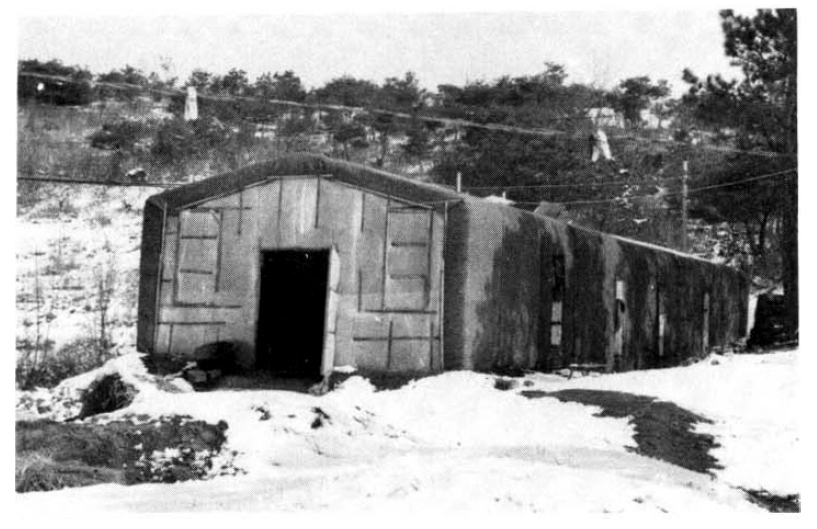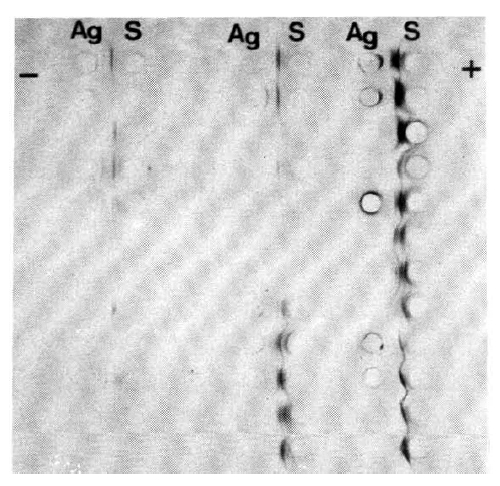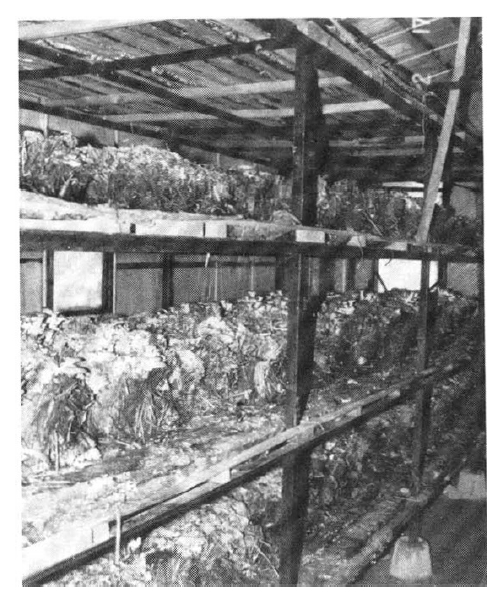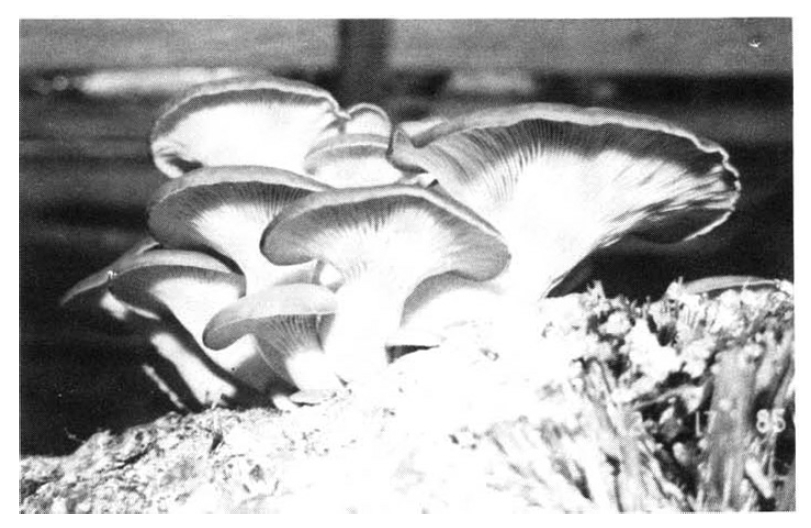 |
 |
| Korean J Intern Med > Volume 6(1); 1991 > Article |
|
Abstract
Some respiratory symptoms in mushroom growers such as mushroom workerŌĆÖs lung develop by inhalation of certain agents arising from the environment of mushroom cultivation. Recently we observed mushroom workers who had respiratory symptoms which might be type III hypersensitivity reaction to the antigen of Pleurotus floridae.
We gave questionaires to all the mushroom growers at one of the biggest cultivation areas of mushrooms, Pleurotus floridae in Pocheon, Kyunggi Province. Those with respiratory symptoms were subjects for the study. CBC, chest X-ray, pulmonary function test, skin test with Pleurotus floridae extract, and precipitin antibody test to Pleurotus floridae were performed in the study subjects.
Out of a total 308 mushroom workers, 23 workers (14 males, 9 females) had respiratory symptoms. Their mean age was 45 years, and their mean duration of engagement was 3.4 years. Their main symptoms were cough (100%), sputum (82.6%), dyspnea (43.5%), and fever with chills (13.0%). Two cases showed increased interstitial lung markings on chest X-ray films. Sixteen cases (73.9%) showed precipitin antibodies against P. floridae extract by counterimmunoelectrophoresis. Antibodies against Micropolyspora faeni and Thermoactinomyces vulgaris were not detected in any subject.
Respiratory disorders can develop in mushroom growers by the inhalation of certain agents arising from the environment of mushroom cultivation houses1ŌĆō4). Mushroom workerŌĆÖs lung is the most important disease among them and is an interstitial lung disease resulting from the immunological reaction to the antigens associated with the organic particles4). It is more common than ordinarily thought5). The causative agents are multiple, and new antigens are being identified continuously6ŌĆō9).
As the commercial demand for mushrooms increases, many Korean farmers have been engaged in mushroom growing during the winter season after harvest. Recently we observed mushroom growers who had respiratory symptoms which might be type III hypersensitivity reaction to the antigen of mushroom, Pleurotus floridae, which was suggested as hypersensitivity pneumonitis. In this article we report the immunologic findings of those subjects with clinical characteristics.
There were 108 mushroom houses in one of the largest cultivation areas of Pleurotus floridae located in Pocheon, Kyeonggi Province, 68km from Seoul, where approximately 308 people were engaged in mushroom growing in 1985. The cultivation house was almost enclosed with a thick wall to protect it from direct sunlight and to insulate it in order to maintain a temperature of 15ŌĆō20┬░C (Fig. 1). It usually had 8 small straw mats on each bed (Fig. 2) and produced numerous basidiospores from the gills of basidiocarps (Fig. 3). The spores were densely dispersed in the air so that the growers inhaled large amounts of basidiospores while they were harvesting mushrooms.
Among 308 mushroom growers, 23 (7.5%) of them (14 male, 9 female) had respiratory symptoms associated with mushroom cultivation (Table 1). Their mean age was 45 years and mean duration of engagement was 3.4 years.
Complete blood count, chest X-ray, and spirometry (FEV1 and flow volume curve) were checked. Skin tests were done by intradermal injection of 0.2 ml of P. floridae extract (100 mcg/ml). Fresh mushroom was homogenized with a blender in normal saline, and then the clear extract was separated from the mycelial debris by centrifugation at 10, 000 rpm for 20 min. The criterion for a positive immediate skin test was a greater reaction than half of the histamine control (0.1 mg/ml). A positive 6-hr skin reaction was > 10 mm induration, and no induration or less than 10 mm was interpreted as negative. Immunodiffusion tests and immunoelectrophoresis were performed in order to detect precipitating antibodies to the Pleurotus floridae antigens in serum specimens collected from all subjects. Antigens of Micropolyspora faenii, Thermoactinomyces vulgaris, and the extracts of other edible mushrooms, Lentinus ebodes and Flammulina velutipes, were also included in this test. Agar gel plate was air-dried and stained with amidoblack (Fig. 4).
The symptoms associated with mushroom cultivation are shown in Table 2. Cough was the most common symptom, and an increased amount of sputum was found in 19 subjects and dyspnea in 7 subjects. Three subjects complained of fever and chill. Complete blood counts were all normal and no eosinophilia seen. Spirometry was also normal in all subjects. Two cases showed slightly increased interstitial markings on chest X-ray (Fig. 5). Precipitating antibodies to P. floridae extracts were found in serum specimens of 16 subjects (Table 3). One to 4 precipitin bands were observed on the counterimmunoelectrophoresis plate. However, none had antibody to M. faenii and T. vulgaris which have been known to be common offending antigens in mushroom workerŌĆÖs lungs.
There was no reaction to the extracts, of L. ebodes and F. velutipes so that it ruled out cross reactions with other edibile mushrooms. Also, none of the normal subjects reacted to P. floridae antigen, suggesting that a positive precipitin reaction to this organism was closely associated with cultivation of this mushroom and related with its symptoms. Levels of total IgE were slightly higher in positive reactors than in negative, but it was not statistically significant.
On the intradermal skin tests, positive immediate reaction was observed in 7 subjects (30.4%) and late reaction in 13 subjects (56.5%) as seen in Table 5. The relationship of precipitating antibody and 6-hr skin reaction is shown in Table 6. Among 13 positive reactors, 11 subjects (84.6%) had precipitating antibodies to P. floridae, and 5 out of 10 negative reactors also had precipitating antibodies.
Since respiratory disorders due to dusts of vegetable origin had been described first by Ramanizzi (1713) in flax workers9), many similar conditions have been recognized10). Campbell described those symptoms as farmerŌĆÖs lung in 193211), and now it has been known as a not infrequent condition occurring in agricultural workers who are often exposed to dusts arising from moldy forage and vegetable matter.
FarmerŌĆÖs lung may be an industrial lung disease due to hypersensitivity to an antigen arising from the dust of moldy forage. Since Pepys et al. (1963) reported that the major antigens involved were the spores of thermophilic actinomycetes growing in the heated hay, a wide variety of organic dusts12) and chemicals has been identified as the causative agents, and new offending agents have come to be known continuously.
Mushroom workerŌĆÖs lung is one type of farmerŌĆÖs lung occurring in mushroom growers. Mushrooms were first grown commercially shortly after the American Civil War. In Korea edible mushroom cultivation has been profitable, so that the number of mushroom growers has recently increased. The most popular species of mushroom is P. floridae, and it grows from November to February during the winter season after harvest. Mushrooms are harvested 2 or 3 times a season.
We observed 23 individuals, who have had respiratory symptoms, out of the 308 mushroom growers in the Pochen area, one of the largest P. floridae cultivation areas (Table 1). Incidence was quite high, and cough and increased sputum were the most common symptoms (Table 2). CBC and spirometry were normal, and chest X-ray revealed an abnormality in only 2 subjects. It was thought that abnormal laboratory findings could not be found because they were checked after cultivation season.
The 16 subjects (69.9%) had precipitin bands to P. floridae extracts by CIEP (Table 3). They did not react to actinomycetes antigens, which were the most frequent cause of farmerŌĆÖs lung, and also to other mushroom antigens and no control subjects reacted to P. floridae antigen. All this evidence suggests that their symptoms might have resulted from the exposure to P. floridae, but it cannot be ruled out that some of them were nonspecific or irritant-induced.
Pepys and Jenkins obtained positive reactions in 91% of the patients with farmerŌĆÖs lung by the double-diffusion test and in 89% in the immunoelectrophoretic test13). Freedman et al. detected precipitating antibody in 61.3% of the patients with farmerŌĆÖs lung14), and ELISA detected antibodies in 77.4% of the cases. Our result, that precipitating antibody was positive in 69.9% by CIEP (Table 3), is similar to that of Freedman et al. but slightly lower than that of Pepys and Jenkins. Approximately 8% to 10% of healthy farmers have circulating antibodies to antigens of causative organisms of farmerŌĆÖs lung14). So it might be possible that some of them in our study had nonspecific or irritant-induced respiratory symptoms.
The existence of type III hypersensitivity reaction may be confirmed by 6-hr skin tests14). A positive 6-hr late skin reaction was observed in 13 (56.5%) cases in this study, and late reaction was observed in 11 (68.8%) out of 16 precipitin positive reactors. This result was comparable with FreedmanŌĆÖs finding (71%). Hypersensitivity pneumonitis is mainly involved by the mechanism of the type III hypersensitivity reaction15,16), but some patients with hypersensitivity pneumonitis may have type I allergic reaction17). Intradermal skin tests revealed that 7 (30.4%) out of 23 subjects showed an immediate reaction in our study. This result was slightly lower than that of Freedman et al. (58%) but higher than that of Pepys and Jenkins (18%). The mechanism of type I reaction in hypersensitiity pneumonitis will be further studied.
In one of the mushroom cultivation areas in Korea, 23 individuals out of 308 mushroom growers had respiratory symptoms which were suggestive of hypersensitivity pneumonitis due to frequent heavy exposure to P. floridae basidiospores during cultivation and harvest. Their precipitin antibody and skin reactions to P. floridae antigen were compatible with such a presumptive diagnosis. However, further studies are required to confirm the diagnosis including lung biopsy and provocation test with inhalation challange.
Fig.┬Ā1
The cultivation house was almost totally enclosed with a thick wall to protect from direct sunlight and to insulate in order to maintain a temperature of 15ŌĆō20┬░C.

Fig.┬Ā4
Agar gel plate stained with amidoblack. Stained bands reveal positive reactions between the subjectŌĆÖs serum and P. floridae extract.

Fig.┬Ā5
This chest X-ray shows slightly increased interstitial markings in both lower lung fields in one subject.

Table┬Ā1
General Information on 23 Mushroom Growers with Repiratory Symptoms
| Sex | Subjects | Mean Age | Mean Duration of Engagement |
|---|---|---|---|
| Male | 14 | 44.4 ┬▒ 9.0 | 3.7 ┬▒ 2.4 (3 mo ŌĆō 7 yr) |
| Female | 9 | 46.9 ┬▒ 7.0 | 3.0 ┬▒ 1.3(1 yr ŌĆō 4 yr) |
|
|
|||
| Total | 23 | 45.0 ┬▒ 8.0 | 3.4 ┬▒ 2.1 (3 mo ŌĆō 7 yr) |
Table┬Ā2
Symptoms Associated with Mushroom Cultivation
| Symptoms | No. of Subjects | % |
|---|---|---|
| Cough | 23 | 100.0 |
| Sputum | 19 | 82.6 |
| Dyspnea | 7 | 43.5 |
| Fever and chill | 3 | 13.0 |
Table┬Ā3
Counterimmunoelectrophoresis of Serum Specimen
| Antigens | Symptomatics (23) | Controls (7) |
|---|---|---|
| P. floridae | 16 | 0 |
| M. faenii | 0 | 0 |
| T. vulgaris | 0 | 0 |
| L. ebodes | 0 | 0 |
| F. velutipes | 0 | 0 |
Table┬Ā4
Clinical Data of Positive Reactors (16) to P. floridae on CIE
|
Precipitating Antibody
|
||
|---|---|---|
| Positive | Negative | |
| Male | 10 | 4 |
| Female | 6 | 3 |
| Mean age (yr) | 47.3┬▒10.3 | 39.8┬▒6.8 |
| Mean duration of engagement (yr) | 3.5┬▒2.3 | 3.3┬▒1.5 |
| Total IgE (PRIST) | 283.6┬▒2.9 | 169.7┬▒6.8 |
REFERENCES
1. Pepys J. Hypersensitivity diseases of the lung due to fungi and organic dusts. Monogr Allergy 4:1. 1964.



2. Mushroom workerŌĆÖs pneumonitis. Stephen D. Lockey. Ann Allergy 33:282. 1974.
5. Emanuel DA, Wenzel FJ, Bowerman CI, Lawyon BR. FarmerŌĆÖs lung. Clinical, pathological and immunological study of twenty-four patients. Am J Med 37:392. 1964.


6. Roberts RC, Moore VL. Immunopathogenesis of hypersensitivity pneumonitis. Am Rev Resp Dis 116:1075. 1977.

7. Fink JN, Sosman AJ, Barboriak JJ, Sohlueter DP, Holmes RA. Pigeon breederŌĆÖs disease. A clinical study of a hypersensitivity pneumonitis. Ann Int Med 68:1205. 1968.


8. Kagen SL, Fink JN, Schlueter DP, Kurup VP, Fruchtman RB. Streptomyces albus: a new cause of hypersensitivity pneumonitis. J Allergy Clin Immunol 68:295. 1981.


9. Hausen BM, Schutz KH, Noster U. Allergic disease caused by the spores of an edible fugus, Pleurotus floridae. Proceedings of the ninth international scientific congress on the cultivation of edible fungi. Taipei 219. 1974.
10. Ramanizzi B. De Morbus Artificium Diatriba, 1713. Chicago: 1940. University of Chicago Press.
12. Pepys J, Jenkins RW, Festenstein GN, Gregory PH, Lacy ME, Skinner LA. FarmerŌĆÖs lung. Thermophilic actinomyceteas a source of farmerŌĆÖs lung hay antigen. Lancet 2:607. 1963.


14. Freedman PM, Ault B, Zeiss CR, Treuhaft MW, Roberts RC, Emanuel DA, Baldauf MC, Matrix JJ Jr. Skin testing in farmerŌĆÖs lung disease. J Allergy Clin Immunol 67:51. 1981.


15. Kawanami O, Basset F, Barrios R, Lacronque JG, Ferrans VJ, Crystal RG. Hypersensitivity pneumonitis in man. Light-and electron-microscopic studies of 18 lung biopsies. Am J Pathol 110:275. 1983.


16. Matrix JJ Jr, Emanuel DA, Dovenbarger WV, Reincke ME, Robert RC, Treuhaft MW. FarmerŌĆÖs lung disease among farmers with precipitating antibodies to the thermoactinomycetes, a clinical immunological study. J Allergy Clin Immunol 62:185. 1978.


17. Cohen SH, Yunginger LW, Flink JN. The role of IgE mediated reactions in hypersensitivity pneumonitis. Am Rev Resp Dis 119(Suppl):64. 1979.





 PDF Links
PDF Links PubReader
PubReader ePub Link
ePub Link Full text via DOI
Full text via DOI Download Citation
Download Citation Print
Print



